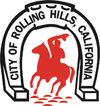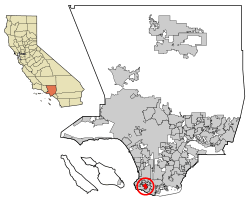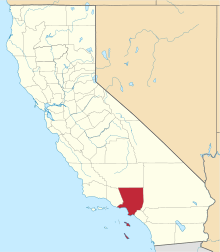Rolling Hills, California
Rolling Hills is a city on the Palos Verdes Peninsula, in Los Angeles County, California, United States. Rolling Hills is a gated community with private roads with three entry gates. Homes are single-story 19th century California ranch or Spanish haciendas exemplified by architect Wallace Neff. Incorporated in 1957, Rolling Hills maintains a rural and equestrian character, with no traffic lights, multi-acre lots with ample space between homes, and wide equestrian paths along streets and property lines.[7]
Rolling Hills, California | |
|---|---|
City in California | |
| City of Rolling Hills | |
 Seal | |
 Location of Rolling Hills in Los Angeles County, California | |
 Rolling Hills, California Location in the United States | |
| Coordinates: 33°45′34″N 118°20′30″W | |
| Country | |
| State | |
| County | |
| Incorporated | January 24, 1957[1] |
| Government | |
| • Type | Council-Manager[2] |
| • Mayor | Dr. James Black[3] |
| Area | |
| • Total | 2.99 sq mi (7.75 km2) |
| • Land | 2.99 sq mi (7.75 km2) |
| • Water | 0.00 sq mi (0.00 km2) 0% |
| Elevation | 1,276 ft (389 m) |
| Population (2010) | |
| • Total | 1,860 |
| • Estimate (2019)[6] | 1,845 |
| • Density | 616.85/sq mi (238.20/km2) |
| Time zone | UTC-8 (Pacific) |
| • Summer (DST) | UTC-7 (PDT) |
| ZIP code | 90274 |
| Area codes | 310/424 |
| FIPS code | 06-62602 |
| GNIS feature IDs | 1661325, 2410986 |
| Website | www |
Rolling Hills has the third highest median house value in the United States.[8][9] Homes are required to have white exterior paint.[7] Homeowners are also required to maintain horse property on their lots, or at minimum keep land where stalls could be built.[7] The community was developed by A.E. Hanson, who also developed Hidden Hills.
Residents work, shop, attend school, and obtain other services in the other towns on the Palos Verdes Peninsula as the only commercially zoned land within the city is occupied by the Rolling Hills City Hall and Rolling Hills Community Association. As of the 2010 census, the city population was 1,860, down from 1,871 at the 2000 census.
Geography
The city borders Rolling Hills Estates to the north and Rancho Palos Verdes on all other sides (including the empty Portuguese Bend landslide area to the south).
Rolling Hills is located at 33°45′34″N 118°20′30″W (33.759350, −118.341550).[10]
According to the United States Census Bureau, the city has a total area of 3.0 square miles (7.8 km2), all land.
Demographics
| Historical population | |||
|---|---|---|---|
| Census | Pop. | %± | |
| 1960 | 1,664 | — | |
| 1970 | 2,050 | 23.2% | |
| 1980 | 2,049 | 0.0% | |
| 1990 | 1,871 | −8.7% | |
| 2000 | 1,871 | 0.0% | |
| 2010 | 1,860 | −0.6% | |
| Est. 2019 | 1,845 | [6] | −0.8% |
| U.S. Decennial Census[11] | |||
At the 2000 census, Rolling Hills was the 21st richest place in the United States (based upon per capita income), and 4th richest for places with a population of at least 1,000.
2010
At the 2010 census Rolling Hills had a population of 1,860. The population density was 622.0 people per square mile (240.1/km2). The racial makeup of Rolling Hills was 1,437 (77.3%) White (74.1% Non-Hispanic White),[12] 29 (1.6%) African American, 5 (0.3%) Native American, 303 (16.3%) Asian, 2 (0.1%) Pacific Islander, 24 (1.3%) from other races, and 60 (3.2%) from two or more races. Hispanic or Latino of any race were 102 people (5.5%).[13]
The whole population lived in households, no one lived in non-institutionalized group quarters and no one was institutionalized.
There were 663 households, 199 (30.0%) had children under the age of 18 living in them, 491 (74.1%) were opposite-sex married couples living together, 27 (4.1%) had a female householder with no husband present, 21 (3.2%) had a male householder with no wife present. There were 11 (1.7%) unmarried opposite-sex partnerships, and 9 (1.4%) same-sex married couples or partnerships. 98 households (14.8%) were one person and 66 (10.0%) had someone living alone who was 65 or older. The average household size was 2.81. There were 539 families (81.3% of households); the average family size was 3.08.
The age distribution was 404 people (21.7%) under the age of 18, 109 people (5.9%) aged 18 to 24, 191 people (10.3%) aged 25 to 44, 643 people (34.6%) aged 45 to 64, and 513 people (27.6%) who were 65 or older. The median age was 51.7 years. For every 100 females, there were 91.8 males. For every 100 females age 18 and over, there were 91.1 males.
There were 663 occupied housing units at an average density of 239.4 per square mile (92.4/km2), of which 635 were owner-occupied, and 28 were occupied by renters. The homeowner vacancy rate was 1.4%; the rental vacancy rate was 3.4%. 1,778 people (95.6% of the population) lived in owner-occupied housing units and 82 people (4.4%) lived in rental housing units.
2000
At the 2000 census there were 1,871 people in 645 households, including 554 families, in the city. The population density was 607.7 inhabitants per square mile (234.5/km2). There were 682 housing units at an average density of 221.5 per square mile (85.5/km2). The racial makeup of the city was 79.8% White, 2.0% African American, 14.0% Asian, 0.5% Pacific Islander, 1.2% from other races, and 2.5% from two or more races. Hispanic or Latino of any race were 4.5%.[14]
Of the 645 households 33.8% had children under the age of 18 living with them, 80.6% were married couples living together, 3.4% had a female householder with no husband present, and 14.1% were non-families. 12.4% of households were one person and 8.1% were one person aged 65 or older. The average household size was 2.90 and the average family size was 3.11.
The age distribution was 25.9% under the age of 18, 4.1% from 18 to 24, 15.1% from 25 to 44, 32.8% from 45 to 64, and 22.1% 65 or older. The median age was 48 years. For every 100 females, there were 96.1 males. For every 100 females age 18 and over, there were 92.5 males.
The median household income was in excess of $200,000, as was the median family income. Males had a median income in excess of $100,000 versus $52,500 for females. The per capita income for the city was $111,031. None of the families and 1.3% of the population were below the poverty line. No one under 18 or older than 65 was living below the poverty line.
Education
The city is served by Palos Verdes Peninsula Unified School District. PVPUSD schools have constantly ranked among the best in California and the nation. Since 2013, the Washington Post has consistently recognized Palos Verdes Peninsula High School in the publication's list of "America's Most Challenging Schools" and once listed it as the 8th best public or private high school in the nation.[15] School data website, niche.com ranked Palos Verdes Peninsula High School #9 of California's best public high schools of 2016.[16] The prestigious Chadwick School is an independent 45 acre, K-12 private school that also serves the area. According to Business Insider, in 2014 niche.com named Chadwick as one of the top private high schools in America.[17]
Politics
In 2009, Rolling Hills had the third highest percentage of registered Republicans of any city in California, with 61.3% of its 1,441 registered voters registered as Republicans. 19.4% of voters were registered Democrats, and 16.3% "declined to state."[18]
Rolling Hills has voted for the Republican candidate in every presidential and gubernatorial election since at least 1962, often by large margins. In 2016, Los Angeles County gave Donald Trump roughly 21% of the vote, and Rolling Hills was one of only five cities in Los Angeles County that was carried by Trump.[19]
| Year | Democratic | Republican | Third Parties |
|---|---|---|---|
| 2016[19] | 35.23% 397 | 58.83% 663 | 5.94% 67 |
| 2012[20] | 26.60% 311 | 71.69% 838 | 1.71% 20 |
| 2008[21] | 33.60% 418 | 64.71% 805 | 1.69% 21 |
| 2004[22] | 28.46% 226 | 70.28% 558 | 1.26% 10 |
| 2000[23] | 23.15% 175 | 73.94% 559 | 2.91% 22 |
| 1996[24] | 21.50% 181 | 71.38% 601 | 7.13% 60 |
| 1992[25] | 16.63% 154 | 59.61% 552 | 23.76% 220 |
| 1988[26] | 16.41% 157 | 82.13% 786 | 1.46% 14 |
| 1984[27] | 13.17% 137 | 85.77% 892 | 1.06% 11 |
| 1980[28] | 10.78% 113 | 82.63% 866 | 6.58% 69 |
| 1976[29] | 13.86% 145 | 84.42% 883 | 1.72% 18 |
| 1972[30] | 14.63% 151 | 81.98% 846 | 3.39% 35 |
| 1968[31] | 14.88% 142 | 80.40% 767 | 4.72% 45 |
| 1964[32] | 21.40% 196 | 78.60% 720 |
| Year | Democratic | Republican | Third Parties |
|---|---|---|---|
| 2018[33] | 33.60% 340 | 66.40% 672 | |
| 2014[34] | 27.41% 213 | 72.59% 564 | |
| 2010[35] | 22.80% 238 | 75.10% 784 | 2.11% 22 |
| 2006[36] | 13.31% 84 | 84.94% 536 | 1.74% 11 |
| 2003[37] | 8.06% 248 | 90.77% 2,792 | 1.17% 36 |
| 2002[38] | 17.90% 104 | 75.73% 440 | 6.37% 37 |
| 1998[39] | 27.35% 189 | 71.64% 495 | 1.01% 7 |
| 1994[40] | 12.71% 126 | 86.58% 858 | 0.71% 7 |
| 1990[41] | 17.11% 519 | 79.16% 2,401 | 3.73% 113 |
| 1986[42] | 12.71% 379 | 86.22% 2,571 | 1.07% 32 |
| 1982[43] | 22.16% 681 | 76.73% 2,358 | 1.11% 34 |
| 1978[44] | 34.06% 947 | 57.41% 1,596 | 8.53% 237 |
| 1974[45] | 22.02% 457 | 76.24% 1,582 | 1.73% 36 |
| 1970[30] | 15.74% 164 | 83.11% 866 | 1.15% 12 |
| 1966[31] | 13.66% 81 | 86.34% 512 | |
| 1962[32] | 17.62% 71 | 80.40% 324 | 1.99% 8 |
NOTE: The totals listed for the 2003 governor's special election are the aggregate totals for all Republican candidates, all Democratic candidates, and all Independent candidates. Individually, Arnold Schwarzenegger received 2,391 votes, Cruz Bustamante received 234 votes, and Tom McClintock received 384 votes.
Government
Rolling Hills was incorporated in 1957. It has a council-manager form of government. The city council consists of five members, one of whom is appointed mayor on an annual basis.[3]
State and federal representation
In the California State Legislature, Rolling Hills is in the 26th Senate District, represented by Democrat Ben Allen, and in the 66th Assembly District, represented by Democrat Al Muratsuchi.[46]
In the United States House of Representatives, Rolling Hills is in California's 33rd congressional district, represented by Democrat Ted Lieu.[47]
Services
The Los Angeles County Sheriff's Department (LASD) operates the Lomita Station in Lomita, serving Rolling Hills.[48]
The Los Angeles County Department of Health Services operates the Torrance Health Center in Harbor Gateway, Los Angeles, near Torrance and serving Rolling Hills.[49]
Notable people
- Tracy Austin, former world #1 tennis player and two-time US Open winner[50]
- Colin Baxter, professional football player[51]
- Parnelli Jones, former professional race car driver and Indy car team owner
- Erik Lorig (born 1986), NFL football player
- Alex McLeod, TV personality and host of Trading Spaces
- Greg Popovich, founder and owner of Castle Rock Winery[52]
- Frank D. Robinson, founder of Robinson Helicopter Company[53]
- Steve Sarkisian, former University of Southern California head football coach[54]
- John Tu, co-founder of Kingston Technology,[55] a privately held, multinational computer technology corporation.
See also
- List of largest houses in the Los Angeles Metropolitan Area
- List of largest houses in the United States
References
- "California Cities by Incorporation Date". California Association of Local Agency Formation Commissions. Archived from the original (Word) on November 3, 2014. Retrieved August 25, 2014.
- "City Manager". City of Rolling Hills. Retrieved February 16, 2015.
- "City Council". Rolling Hills, CA. Retrieved March 30, 2015.
- "2019 U.S. Gazetteer Files". United States Census Bureau. Retrieved July 1, 2020.
- "Rolling Hills". Geographic Names Information System. United States Geological Survey. Retrieved November 11, 2014.
- "Population and Housing Unit Estimates". United States Census Bureau. May 24, 2020. Retrieved May 27, 2020.
- "History of Palos Verdes Real Estate in Rolling Hills". PVBrokers.net. Retrieved March 25, 2015.
- "Top 100 cities with highest median house value". city-data.com. Retrieved March 25, 2015.
- Slater, Eric (June 13, 1996). "Rolling Hills Named Richest in Nation". Los Angeles Times. Retrieved April 8, 2018.
- "US Gazetteer files: 2010, 2000, and 1990". US Census Bureau. February 12, 2011. Retrieved April 23, 2011.
- "Census of Population and Housing". Census.gov. Retrieved June 4, 2015.
- "Profile of General Population and Housing Characteristics: 2010". Census.gov. US Census Bureau, US Dept. of Commerce. Retrieved March 25, 2015.
- "2010 Census Interactive Population Search: CA - Rolling Hills city". US Census Bureau. Archived from the original on July 15, 2014. Retrieved July 12, 2014.
- "U.S. Census website". US Census Bureau. Retrieved January 31, 2008.
- "Palos Verdes Peninsula High School Ranking". Washington Post.
- "California's Best Public High Schools 2016". niche.com.
- "Best Private High Schools in America 2014". Business Insider.
- "Registration by Political Subdivision by County" (PDF). California Secretary of State. May 4, 2009. pp. 103–190. Archived from the original (PDF) on March 29, 2012. Retrieved March 27, 2015.
- "Election data" (PDF). elections.cdn.sos.ca.gov. Retrieved August 8, 2020.
- "Election data" (PDF). elections.cdn.sos.ca.gov. Retrieved August 8, 2020.
- "Election data" (PDF). elections.cdn.sos.ca.gov. Retrieved August 8, 2020.
- "Election data" (PDF). elections.cdn.sos.ca.gov. Retrieved August 8, 2020.
- "Election data" (PDF). elections.cdn.sos.ca.gov. Retrieved August 8, 2020.
- "Election data" (PDF). elections.cdn.sos.ca.gov. Retrieved August 8, 2020.
- "Election data" (PDF). elections.cdn.sos.ca.gov. Retrieved August 8, 2020.
- "Statement of vote : California. Secretary of State : Free Download, Borrow, and Streaming". Internet Archive.
- "Statement of vote : California. Secretary of State : Free Download, Borrow, and Streaming". Internet Archive.
- "Statement of vote : California. Secretary of State : Free Download, Borrow, and Streaming". Internet Archive.
- "Statement of vote : California. Secretary of State : Free Download, Borrow, and Streaming". Internet Archive.
- "Statement of vote : California. Secretary of State : Free Download, Borrow, and Streaming". Internet Archive.
- "California statement of vote : California. Secretary of State : Free Download, Borrow, and Streaming". Internet Archive.
- "California statement of vote : California. Secretary of State : Free Download, Borrow, and Streaming". Internet Archive.
- "Election data" (PDF). elections.cdn.sos.ca.gov. Retrieved August 8, 2020.
- "Election data" (PDF). elections.cdn.sos.ca.gov. Retrieved August 8, 2020.
- "Election data" (PDF). elections.cdn.sos.ca.gov. Retrieved August 8, 2020.
- "Election data" (PDF). elections.cdn.sos.ca.gov. Retrieved August 8, 2020.
- "Statement of vote : California. Secretary of State : Free Download, Borrow, and Streaming". Internet Archive.
- "Election data" (PDF). elections.cdn.sos.ca.gov. Retrieved August 8, 2020.
- "Statement of vote : California. Secretary of State : Free Download, Borrow, and Streaming". Internet Archive.
- "Election data" (PDF). elections.cdn.sos.ca.gov. Retrieved August 8, 2020.
- "Election data" (PDF). elections.cdn.sos.ca.gov. Retrieved August 8, 2020.
- "Statement of vote : California. Secretary of State : Free Download, Borrow, and Streaming". Internet Archive.
- "Statement of vote : California. Secretary of State : Free Download, Borrow, and Streaming : Internet Archive". Internet Archive. June 10, 2020. Retrieved August 8, 2020.
- "Statement of vote : California. Secretary of State : Free Download, Borrow, and Streaming". Internet Archive.
- "Statement of vote : California. Secretary of State : Free Download, Borrow, and Streaming". Internet Archive.
- "Statewide Database". UC Regents. Archived from the original on February 1, 2015. Retrieved February 11, 2015.
- "California's 33rd Congressional District - Representatives & District Map". Civic Impulse, LLC.
- "Lomita Station Archived January 23, 2010, at the Wayback Machine." Los Angeles County Sheriff's Department. Retrieved on January 21, 2010.
- "Torrance Health Center." Los Angeles County Department of Health Services. Retrieved on March 18, 2010.
- "
- Armstrong, Kevin; Mehta, Manish (September 20, 2011). "Nick Mangold out two-to-three weeks with high ankle sprain, Jets turn to reserve center Colin Baxter". Daily News. New York. Retrieved December 21, 2013.
- Foss, Richard (April 30, 2012). "Castle Rock Winery Partners – A remote peninsula winery". Easy Reader News. Retrieved December 13, 2019.
- "Frank Robinson". Blockshopper.com.
- "
- "John Tu". Forbes.
External links
- Official website

- Lomita Sheriff Station, LA County Disaster Communications Service (DCS)
.jpg)

